Tags
This is the seventy-ninth in a series of posts on the Vietnam War. See here for the previous post in the series or go back to the master post.
It took a few weeks but I’ve caught up to where I started with my A-1 Skyraider flights in IL-2. You’ll recall that I used the bounty of scenarios, from 1964 into 1967, as a training program. Training for IL-2, training for close air support, and training for the A-1 aircraft.
The naval version of the plane was a tough one. I never did manage to get my plane off of the carrier deck and did an awful job with the landings. Or, I should say, awful when I even made it home at all – the flights into North Vietnam were, for me, typically a one-way ride.
After a fistful of Navy missions, I took on a few of the Marine missions. These worked out a little better. I am capable of taking off from a runway (at least, after a little practice, more often than not) and can occasionally land. The Marine missions are also a little easier overall. The AAA over North Vietnam is deadly and I frequently received fatal hits at altitude before even starting my run at the target. Close Air Support missions still have their dangers, but the danger is much more manageable.
I am now at the the Midnight Raiders scenario, which is a part of the Wings over ‘Nam (1965-1973) package. We’ve sampled this set before. It is a set of fictional scenarios but they are set against a background of plausibly-historical situations.
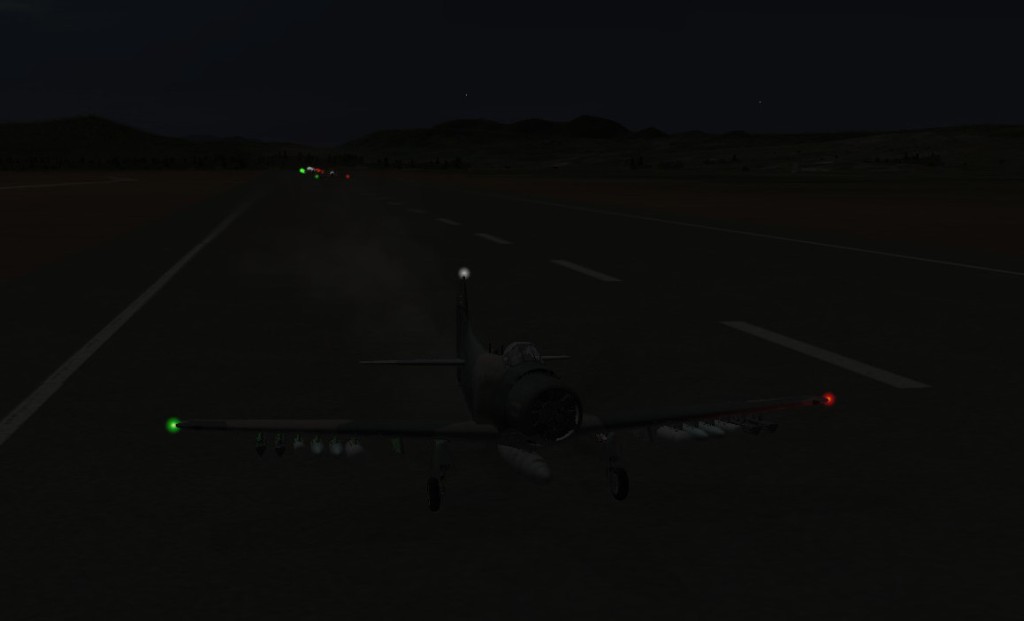
In this case, there is a “Marines frontline camp,” situated on the map just north of Dak To, which is under a nighttime attack by enemy infantry. The camp has called in air support which is being supplied by A-1 Skyraiders* and a AC-47 Spooky out of Pleiku Airbase. Note that, in reality, any of the fighting north of Dak To in August of 1967 would have been the 4th Infantry, which was tasked with Operation Greeley. Nonetheless, I can accept this one for what it is and, as such, it provides a nifty gaming experience.
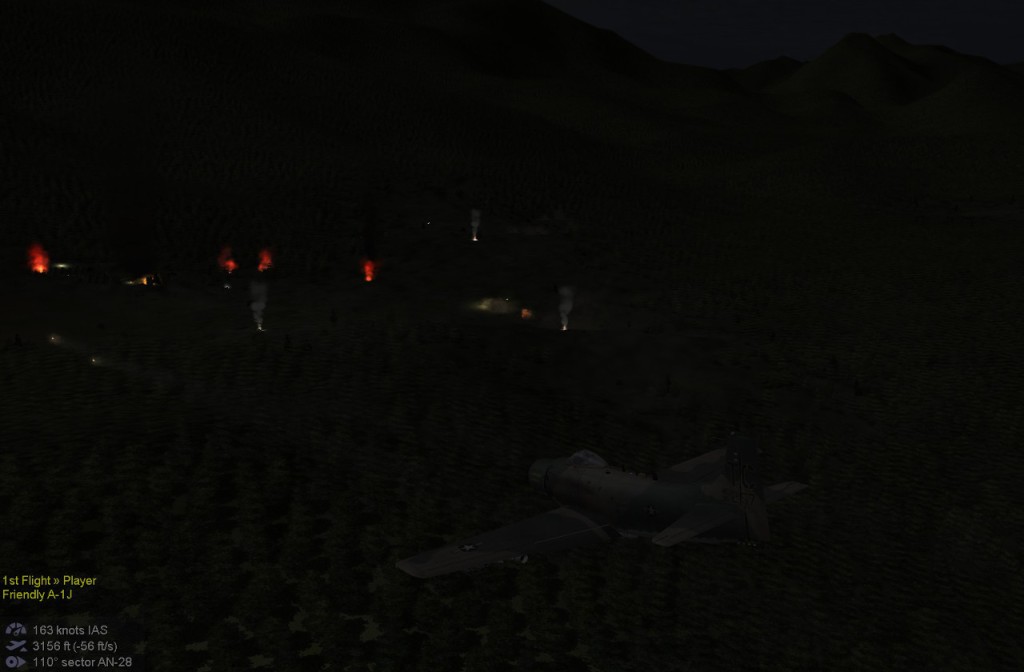
The key is that this is, as I said, a night mission. The feel is very different from the daytime missions that make up the bulk of the available scenarios. The flight takes place on a night with plenty of moonlight, so it isn’t a case that you’re “flying blind.” Nonetheless, there is a difference in the kind of “assistance” you require and get. Flares and starshells take the place of smoke. Burning bits of jungle help locate battle hot-spots from a distance in a way that just doesn’t work during the day. Plus, and it bears repeating, you’re not facing down that savage North Vietnamese anti-air.
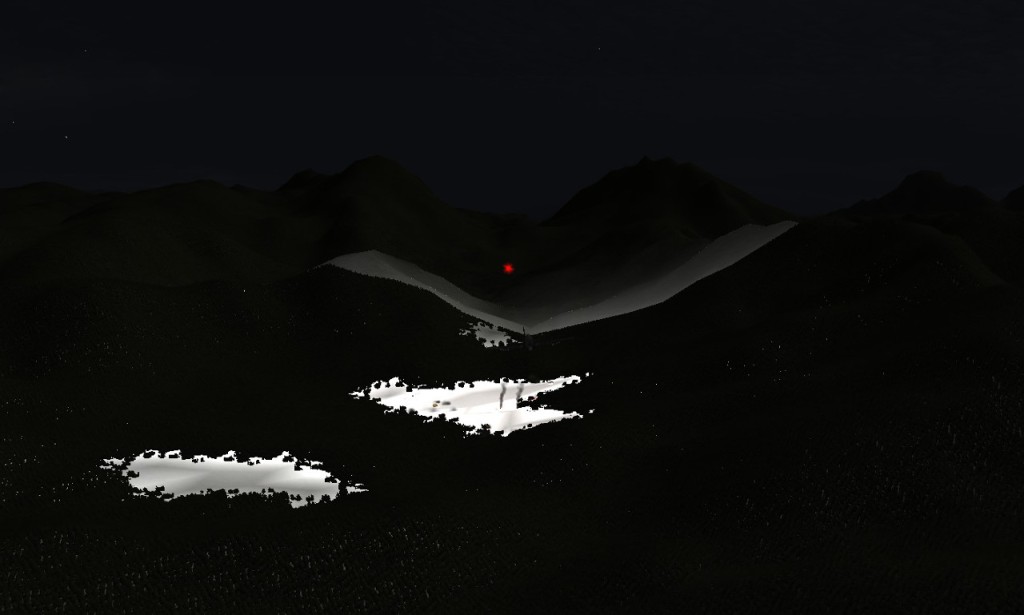
With everything going so smoothly lately (well, my inability to do carrier take-offs notwithstanding), I needed a reminder that I’m playing a user-built scenario in a community patched-up-and-modded game from twenty years ago. See the screenshot above. For no reason that I could figure, the ground beneath the battlefield lit up like a stadium. The effect came and went a number of times. My best guess is that it may be an artifact related to the starshell – I don’t know, and I’m not going to fret it.
I’ve also discovered that I am having some trouble matching up my list of missions in the installation directory with the selection list in-game. I haven’t figured this one out yet either but, whatever is going on, it doesn’t seem to effect the Wings over ‘Nam (1965-1973) offerings.
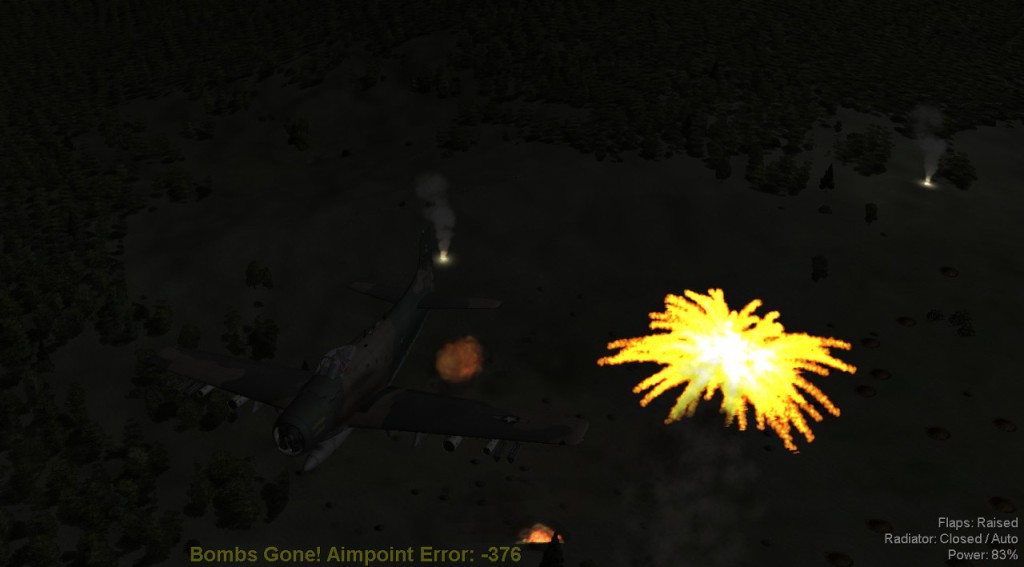
I probably should fret my inability to hit anything with bombs. Despite all my “training,” every time it comes to letting go with my bomb load, I find myself in a semi-panic. I’m suddenly flustered that I am moving too fast, not lined up right, and (come to think of it) not even sure if that is the right target. So I squeeze the button just as my aircraft goes into an unplanned roll. Although I did destroy a few enemies in this play-through, I suspect the damage was all with my rockets.
So while my “training” program did not even make me a competent pilot, I did learn a few things from my exercise. First, the “Level Stabilize” and “Level Autopilot” are not the same thing – I learned that the hard way. Also, while playing one of the earlier US Marine close-air-support missions I noticed that my wingman was using a pretty good sized aerobraking** setup to facilitate dive bombing. I added brake deployment to my stick functionality and made it part of my own repertoire.
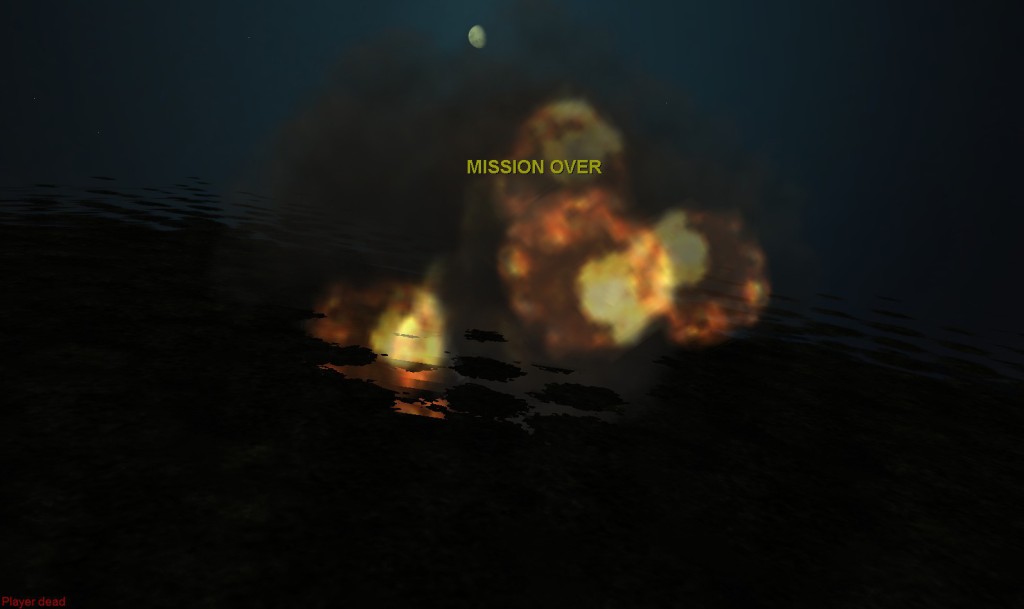
One thing I could not seem to learn is where that mountain sits relative to the battlefield. Crossing the target area in an East-North-East trajectory points your plane straight at a mountain. If you’ve gone over the target at low altitude (and I always seem to have done so) then it is a steep climb out of the valley. Although it looks doable from the outset, three dead pilots in a row inform me that it is not. The plane will run out of speed and stall just as it crests that hill.
Return to the master post for the Vietnam War. In the next article I again try to relieve a Marine outpost under siege, but this time from the ground.
*The scenario uses the A-1J. This is the final production version of the aircraft, with a stronger engine and reinforced structure relative to the more numerous A-1H. I don’t know how available the J was, so I’m not complaining about that. However, there was also a night-attack version, the A-1G. Unless these aircraft were entirely unavailable, it would have seemed foolish to put up the daytime version of the aircraft. It is not a variant available in this game. The A-1G was a four-seat aircraft and would fly very differently that the single-seaters in this game.
**The dive brakes were introduced on the A-1H model. I didn’t go back and check mission-by-mission but I am pretty sure that the earlier naval missions that I played used a different version of the aircraft and properly wouldn’t have had this feature.

Pingback: Giggity | et tu, Bluto?
Pingback: With Positive Reply | et tu, Bluto?
Pingback: Pulled My Trigger, Now He’s Dead | et tu, Bluto?
Pingback: Between the Heavens and the Corner of some Foreign Field | et tu, Bluto?